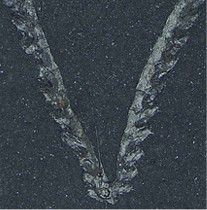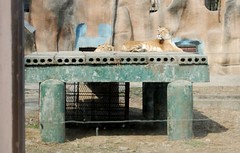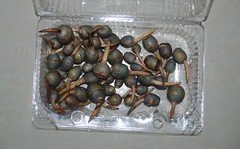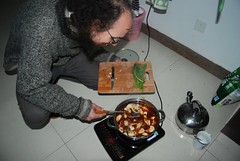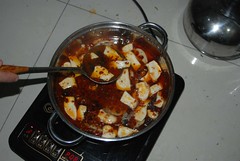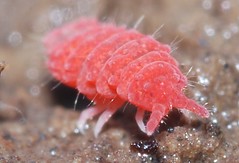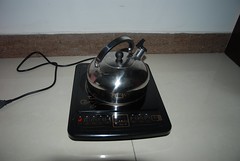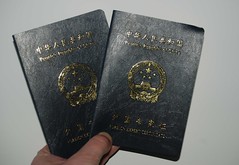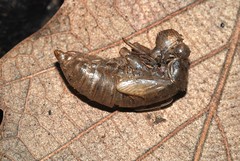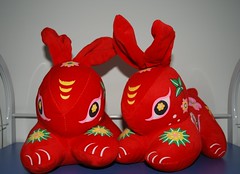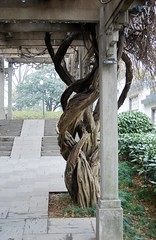Joe has told me that I write far too many blog posts about food. So, since we promised lots of posts about geology, and have managed hardly any, here is one on graptolites.
No, not the latest diet fad, but a type of fossil. This one is called Dicellograptus cambriensis*, from the Ordovician (about 450 million years ago) of Wales. Each of the branches is about 2 cm long. This is one of average-ish size, but they ranged from a couple of millimetres to more than a metre and a half long. As with most fossils, their soft tissue has rotted away, and only the more decay-resistant part is left. This is made of a protein similar to collagen (what your skin is made from).
Graptolites were animals, and the ones that most graptolite workers study** floated/swam*** in the sea during the Ordovician, Silurian and Devonian periods (between about 488 and 407 million years ago)****. Their main use is for dating rocks - they are found all over the world, there were many different species, and most of the species did not exist for very long. This means that if you look in rocks of the right type, you're likely to find graptolites. If you know which species you are looking at, you know exactly how old the rocks are. This is useful if you are looking for oil, trying to find gold, or are just trying to make an accurate geological map.
Of course, I still haven't told you much about what they actually were. That's because we don't know very much. We know a lot about the structure of their skeleton - in the example here, each branch is a series of tubes piled up obliquely. Each protrusion on the branches is the mouth of a tube. We know that they were colonial, like a coral, with individuals living in the tubes. However, we don't know how many individuals lived in each tube. Was there one big animal per tube (like one of their living relatives) or several small ones (like their other living relative)?
So, we know a lot about graptolites in terms of which species lived when, and which species evolved into which others. We know very little about them as living animals though, and that is the part that I find most interesting.
Lucy
*The fossil name ought to be in italics, but I don't seem to be able to do that via flickr, so please just pretend the italics are there.
**There are a number of other types, but we don't usually talk about them.
***I am being deliberately vague, but they definitely did one or the other, or possibly both. Ask two graptolite workers and you'll get three different opinions.
****There are relatives of graptolites living today, but unless you have a zoology degree you probably won't have heard of them. If you're interested, the names to look up are Rhabdopleura and Cephalodiscus.
Sunday 27 February 2011
Sunday 20 February 2011
Royal Tea
Browsing in the supermarket, I spotted this: British-style Royal Milk Tea. I couldn't resist the chance to see what the Chinese think British tea is like.
Lower photo shows the contents of the cup: tea powder and milk powder mixed. The little plastic pot contains jelly. Yes, you read that correctly, jelly. There was also a straw, the reason for which became clear after making the tea.
Upon adding hot water, the powder dissolved and the jelly sank to the bottom. The straw is for drinking the tea and sucking up the small pieces of jelly. It tasted like a cup of medium-strength tea with UHT milk. The pieces of jelly at the bottom didn't melt, but stayed as small cubes to be chewed. Nice, but I certainly wouldn't give it to the Queen.
Lower photo shows the contents of the cup: tea powder and milk powder mixed. The little plastic pot contains jelly. Yes, you read that correctly, jelly. There was also a straw, the reason for which became clear after making the tea.
Upon adding hot water, the powder dissolved and the jelly sank to the bottom. The straw is for drinking the tea and sucking up the small pieces of jelly. It tasted like a cup of medium-strength tea with UHT milk. The pieces of jelly at the bottom didn't melt, but stayed as small cubes to be chewed. Nice, but I certainly wouldn't give it to the Queen.
Tuesday 15 February 2011
Ligers and I
Had a trip to the zoo on saturday! It's set among wooded hills and ancient quarries, so it's quite spread out with a decent amount of walking between the enclosures, fairgrounds, and other bits and pieces. Some parts (the crowded ones) were pretty horrendous, but there are some beautiful little spots amongst bamboo groves away from the madding crowd... Anyway, just wanted to tell you about some strange goings on that are still leaving us baffled...
Ligers are truly magnificent animals - absolutely enormous, and the photo clearly doesn't do them justice. It's amazing how these cross-breeds of lions and tigers are actually bigger than either! Anyway, there were two, in a big enclosure, prowling around and being admired by a small but noisy crowd of onlookers, and separated by nothing more than plate glass...
Despite the crowds of tourists, one of the ligers became obsessed with us. It was staring at us wherever we went, until we started to get slightly unnerved. In the spirit of true scientific enquiry, we split up, one of us going for a wander at a time, to see who it followed. It was definitely me (Joe). Seeming to realise we were playing some game, it gave me a rather worrying growl, before crawling away from us backwards until we could only see its eyes, staring at us... It was really quite spooky.
Even stranger, one of the spider monkeys had a similar reaction, although in that case it merely seemed confused and curious. When we left, it ran around the cage until it couldn't get any further... and it was obviously us again, with several people in the crowd laughing and pointing.
We wondered whether it was the beard. If it gets too hot in the summer and I have to shave it off, we'll go back and re-run the experiment. As long as the snakes on fieldwork don't share this fascination, we'll be fine...
Ligers are truly magnificent animals - absolutely enormous, and the photo clearly doesn't do them justice. It's amazing how these cross-breeds of lions and tigers are actually bigger than either! Anyway, there were two, in a big enclosure, prowling around and being admired by a small but noisy crowd of onlookers, and separated by nothing more than plate glass...
Despite the crowds of tourists, one of the ligers became obsessed with us. It was staring at us wherever we went, until we started to get slightly unnerved. In the spirit of true scientific enquiry, we split up, one of us going for a wander at a time, to see who it followed. It was definitely me (Joe). Seeming to realise we were playing some game, it gave me a rather worrying growl, before crawling away from us backwards until we could only see its eyes, staring at us... It was really quite spooky.
Even stranger, one of the spider monkeys had a similar reaction, although in that case it merely seemed confused and curious. When we left, it ran around the cage until it couldn't get any further... and it was obviously us again, with several people in the crowd laughing and pointing.
We wondered whether it was the beard. If it gets too hot in the summer and I have to shave it off, we'll go back and re-run the experiment. As long as the snakes on fieldwork don't share this fascination, we'll be fine...
Sunday 13 February 2011
water chestnuts
We were given a box of vegetables as a New Year present.* The things pictured were included in it. Not know what they were or how to cook them, we decided that boiling worked for most things, and put them in a soup. They were delicious.
I managed to find out what they are from Google, and found to my surprise that they are water chestnuts. I've had them before, but only as tasteless crunch in stir-fries. Frankly, I wondered why anyone would bother with them. Fresh ones, however, are completely different - they have a floury texture and subtle taste, rather like potatoes.
*Judging by what's on offer in the local supermarket, acceptable New Year gifts include, but are not limited to, boxes of fruit, coffee, and thermal underwear.
I managed to find out what they are from Google, and found to my surprise that they are water chestnuts. I've had them before, but only as tasteless crunch in stir-fries. Frankly, I wondered why anyone would bother with them. Fresh ones, however, are completely different - they have a floury texture and subtle taste, rather like potatoes.
*Judging by what's on offer in the local supermarket, acceptable New Year gifts include, but are not limited to, boxes of fruit, coffee, and thermal underwear.
Saturday 12 February 2011
hotpot 1
This was our tea tonight. It's hotpot, a traditional Chinese dish, from the Chongqing region. It's a bit like a fondue, with a sauce of water, oil and a spice mix consisting mostly of chilli and Szechuan peppercorns. Food is boiled in this sauce and fished out with chopsticks when ready. Not to be gone near unless you like really hot food.
hotpot 2
A close-up of the hotpot. We had lotus root, mushrooms, rice noodles, spinach and potato. The nice thing about cooking this, apart from the spiciness, is that if you can keep cooking and eating things for as long as you're hungry.
Friday 11 February 2011
Who's had too many raspberries, then?
Thanks for the title inspiration, Liam! ;-)
Yes, it's time for another dose of little leggy things, I'm afraid - there's just no getting away from them around here. This enchanting little critter is a springtail, or collembolan. They've got six legs and a pair of antennae, and that ought to be enough to make them insects... but it isn't quite. These things don't have wings, and they've never had them (unlike ants, for example). They also have a soft, velvety cuticle rather than hard plates, and they get their name from a springy fork underneath them - release the catch, and wheeeee...!
Sadly, this group of springtails doesn't do that, which at least makes them much easier to photograph. There was a thin silver one boinging around everywhere, but I gave up on that. In general, springtails are a rather poorly-studied group, perhaps largely because among the biggest one of all is a whopping 17 mm long, and most of them are less than 1 mm (this one was around 2 mm, but at least it stood out!). Regardless, new species are still turning up all the time in China, and there are probably not that many people looking. There's little chance of me recognising anything interesting, I hasten to add... but it is at least a chance to introduce you all to something different!
Just as an aside, these have got about the simplest compound eyes that it's possible to have... each has two lenses, that you can just make out as little black dots, roughly where you'd expect the eyes to be. If not, just imagine it's got eyes wherever you want to stick them. So, is anyone getting to be convinced that our little friends can be cute, yet?
Yes, it's time for another dose of little leggy things, I'm afraid - there's just no getting away from them around here. This enchanting little critter is a springtail, or collembolan. They've got six legs and a pair of antennae, and that ought to be enough to make them insects... but it isn't quite. These things don't have wings, and they've never had them (unlike ants, for example). They also have a soft, velvety cuticle rather than hard plates, and they get their name from a springy fork underneath them - release the catch, and wheeeee...!
Sadly, this group of springtails doesn't do that, which at least makes them much easier to photograph. There was a thin silver one boinging around everywhere, but I gave up on that. In general, springtails are a rather poorly-studied group, perhaps largely because among the biggest one of all is a whopping 17 mm long, and most of them are less than 1 mm (this one was around 2 mm, but at least it stood out!). Regardless, new species are still turning up all the time in China, and there are probably not that many people looking. There's little chance of me recognising anything interesting, I hasten to add... but it is at least a chance to introduce you all to something different!
Just as an aside, these have got about the simplest compound eyes that it's possible to have... each has two lenses, that you can just make out as little black dots, roughly where you'd expect the eyes to be. If not, just imagine it's got eyes wherever you want to stick them. So, is anyone getting to be convinced that our little friends can be cute, yet?
Wednesday 9 February 2011
Rice cooker
Essential in the Chinese kitchen. Three settings: cook, warm and unplugged. Easy to use: place rice and water in the black cooking bowl, put in rice cooker, put lid on, turn switch to cook. When the rice is either done or boiling over, turn switch to warm. Ours also has a steamer on top (not in this photo), for cooking dumplings and similar.
For those of you interested in how things work, it works by induction. Underneath the bowl that the rice goes in is an induction coil (separate picture on flickr). An electric current is passed through it, which generates a magnetic field, which generates an electric current in the cooking vessel, which then gets warm, which cooks the food. Very efficient - none of this heating something to heat something else to heat the food lark. Also doesn't generate much excess heat, useful in the stifling Chinese summer. The stove works the same way.
For those of you interested in how things work, it works by induction. Underneath the bowl that the rice goes in is an induction coil (separate picture on flickr). An electric current is passed through it, which generates a magnetic field, which generates an electric current in the cooking vessel, which then gets warm, which cooks the food. Very efficient - none of this heating something to heat something else to heat the food lark. Also doesn't generate much excess heat, useful in the stifling Chinese summer. The stove works the same way.
How we cook
How do people living in apartments without a separate kitchen cook? We have a rice cooker (see next post), and this stove. For equipment, we have one saucepan, one wok and a steamer that will go on the rice cooker. So, no pies, casseroles or roasted vegetables, just simple soups or stir-fries with rice or noodles. Although there’s only room for one thing at a time on the stove, as it works by induction (see post on rice cooker) it's very fast and efficient.
For flavourings we have sesame oil, rice vinegar, dark and light soy sauces, dried red chillis, ginger, garlic, sesame seeds, Szechuan peppercorns and ground cumin, plus chilli sauce. Chinese cooking doesn’t use a lot of spices, and we haven’t yet seen anything like coriander or turmeric for sale.
For flavourings we have sesame oil, rice vinegar, dark and light soy sauces, dried red chillis, ginger, garlic, sesame seeds, Szechuan peppercorns and ground cumin, plus chilli sauce. Chinese cooking doesn’t use a lot of spices, and we haven’t yet seen anything like coriander or turmeric for sale.
Monday 7 February 2011
Officially experts!
One of the many essential pieces of paper involved in getting the Chinese residence permit is this Foreign Expert Certificate. "The bearer of the Certificate is a foreign expert" it says. Unfortunately we have to give the certificate back when we leave China, but until then it's rather good for the ego.
Chris Nedin: Yes, we agree, the reconstruction isn't scientifically rigorous, but it gets the general idea across to those people who haven't met anomalocaridids before. This is a problem with many reconstructions of fossils: they are done by artists, not palaeontologists.
Chris Nedin: Yes, we agree, the reconstruction isn't scientifically rigorous, but it gets the general idea across to those people who haven't met anomalocaridids before. This is a problem with many reconstructions of fossils: they are done by artists, not palaeontologists.
Saturday 5 February 2011
Introducing the Chengjiang Biota
Nanjing is the centre of studies on the Chengjiang Biota. For most of you, that will probably mean nothing at all, so I suppose I'd best explain...
Way back in the Cambrian times (around 542-488 million years ago), recognisable animals appear in the fossil record. Not just one or two, but billions of them, representing most of the major groups (phyla) alive today. The record of trails and burrows also dramatically increases at the same time, which means it isn't entirely a question merely of the fossils being preserved for the first time (although there is probably an element of that too). We call this the Cambrian Explosion.
The reason we know so much is that just at this critical time is that we're lucky enough to have a whole host of exceptionally preserved fossil faunas. The most famous is the Burgess Shale from the Middle Cambrian of Canada, after which the Burgess Shale-type faunas in general are known. It has, however, been largely superceded by an earlier (Early Cambrian) and equally spectacular fauna from China: the Chengjiang Biota.
These faunas contain a wide range of creatures, and both fossils and reconstructions are on display in the Nanjing Museum of Palaeontology, at the Institute. The big beastie in this picture is an anomalocarid - probably the top predators of the time, and distantly related to modern crustaceans, spiders and their jointy-limbed families. At top right is an eldoniid - what that is, we have too many ideas and no consensus. The same goes for the vetulicolian in front of the anomalocaridid's grasping appandages, and it's a group that has been the source of many arguments in recent years. Arthropod, or fish-like creature? Despite exquisite detail, it's so different to anything alive now that it's hard to say.
There are various sponges, arthropods and so forth in the background - both the Burgess and Chengjiang have well over a hundred species known so far, and more still turning up. And in China, there are now a host of new deposits that look to rival Chengjiang - Guanshan, Kaili, Hetang, Zunyi... this is why palaeontologists worldwide are now looking to China with envy!*
* Well, the feathered dinosaurs help a bit. As do the Precambrian embryos, the dinosaur nests, the...
Way back in the Cambrian times (around 542-488 million years ago), recognisable animals appear in the fossil record. Not just one or two, but billions of them, representing most of the major groups (phyla) alive today. The record of trails and burrows also dramatically increases at the same time, which means it isn't entirely a question merely of the fossils being preserved for the first time (although there is probably an element of that too). We call this the Cambrian Explosion.
The reason we know so much is that just at this critical time is that we're lucky enough to have a whole host of exceptionally preserved fossil faunas. The most famous is the Burgess Shale from the Middle Cambrian of Canada, after which the Burgess Shale-type faunas in general are known. It has, however, been largely superceded by an earlier (Early Cambrian) and equally spectacular fauna from China: the Chengjiang Biota.
These faunas contain a wide range of creatures, and both fossils and reconstructions are on display in the Nanjing Museum of Palaeontology, at the Institute. The big beastie in this picture is an anomalocarid - probably the top predators of the time, and distantly related to modern crustaceans, spiders and their jointy-limbed families. At top right is an eldoniid - what that is, we have too many ideas and no consensus. The same goes for the vetulicolian in front of the anomalocaridid's grasping appandages, and it's a group that has been the source of many arguments in recent years. Arthropod, or fish-like creature? Despite exquisite detail, it's so different to anything alive now that it's hard to say.
There are various sponges, arthropods and so forth in the background - both the Burgess and Chengjiang have well over a hundred species known so far, and more still turning up. And in China, there are now a host of new deposits that look to rival Chengjiang - Guanshan, Kaili, Hetang, Zunyi... this is why palaeontologists worldwide are now looking to China with envy!*
* Well, the feathered dinosaurs help a bit. As do the Precambrian embryos, the dinosaur nests, the...
Friday 4 February 2011
A promise of things to come...
For those of us who want to know, that is. This here is the last moult of a cicada, those wonderful, noisy (and gigantic) relatives of leafhoppers and greenfly. The summer around here is positively buzzing with the racket of cicadas in the treetops. There are quite a few Chinese species, and they're unavoidable enough to feature quite widely in traditional folklore.
Now, I realise there are some among you, dear readers, whose reaction to this might differ to mine. "Yuk!" and "Eurghhh" spring to mind. Well, you're going to have to get use to it, because there will be lots more where this comes from, and with any luck over the coming months I'll manage to persuade you about how gorgeous these little bugs and beasties really are.
Cicadas are "true bugs" (order Hemiptera), as are aphids, shieldbugs and assassin bugs. Every entomologist has their favourite groups (simply because there are far too many to know about all of them!) and this one is mine. It was the amazing colouring and patterns on British leafhoppers that got me interested in the first place, and the Chinese ones should be just as spectacular, if not more so. Cicadas are among the largest of bugs, and are remarkable in spending almost their entire life (several years in many species) underground as nymphs, feeding on roots. The American periodic cicada stays underground for 17 years, before appearing, all at once, over the space of few days. How they co-ordinate this feat is one of those things that just needs to be admired and not worried about too much...
So that's how I know this was the last moult - if it wasn't, it would still be underground. I can't wait until the summer, when i can show you just how gorgeous the adults are. Assuming we can find them.
Now, I realise there are some among you, dear readers, whose reaction to this might differ to mine. "Yuk!" and "Eurghhh" spring to mind. Well, you're going to have to get use to it, because there will be lots more where this comes from, and with any luck over the coming months I'll manage to persuade you about how gorgeous these little bugs and beasties really are.
Cicadas are "true bugs" (order Hemiptera), as are aphids, shieldbugs and assassin bugs. Every entomologist has their favourite groups (simply because there are far too many to know about all of them!) and this one is mine. It was the amazing colouring and patterns on British leafhoppers that got me interested in the first place, and the Chinese ones should be just as spectacular, if not more so. Cicadas are among the largest of bugs, and are remarkable in spending almost their entire life (several years in many species) underground as nymphs, feeding on roots. The American periodic cicada stays underground for 17 years, before appearing, all at once, over the space of few days. How they co-ordinate this feat is one of those things that just needs to be admired and not worried about too much...
So that's how I know this was the last moult - if it wasn't, it would still be underground. I can't wait until the summer, when i can show you just how gorgeous the adults are. Assuming we can find them.
Wednesday 2 February 2011
Year of the rabbit
Happy New Year of the rabbit to everyone!
They like their fireworks here. All day yesterday people were letting off firecrackers in the street. These are long strings of fireworks wrapped in red paper. You put it on the pavement, light one or both ends, and stand back a bit. They make a loud bang but not much of a flash, so good for daylight.
There were a lot of fireworks around 8.30 p.m. - more firecrackers, but also rockets.
At midnight, the whole city let off fireworks simultaneously. The sky was so bright that it could have been daylight. I was particularly impressed by the person in the building opposite who had fire fountains coming out of their window. Someone had a whole line of rockets and firecrackers on the nearby pedestrian crossing - fortunately there wasn't much traffic at the time. There were rockets being set off from the pavement in front of our building, which were exploding in front of our window.
The firecrackers started up again about 7 a.m., and are still going.
They like their fireworks here. All day yesterday people were letting off firecrackers in the street. These are long strings of fireworks wrapped in red paper. You put it on the pavement, light one or both ends, and stand back a bit. They make a loud bang but not much of a flash, so good for daylight.
There were a lot of fireworks around 8.30 p.m. - more firecrackers, but also rockets.
At midnight, the whole city let off fireworks simultaneously. The sky was so bright that it could have been daylight. I was particularly impressed by the person in the building opposite who had fire fountains coming out of their window. Someone had a whole line of rockets and firecrackers on the nearby pedestrian crossing - fortunately there wasn't much traffic at the time. There were rockets being set off from the pavement in front of our building, which were exploding in front of our window.
The firecrackers started up again about 7 a.m., and are still going.
Tuesday 1 February 2011
Wisteria
Just another little spot on the Xuanwu Lake islands... this was a long paved path with a roof of branches. I wanted to get a picture of the whole thing, but there a gaggle of cleaners in fluorescent jackets who kept getting in the way... and they weren't going anywhere, because there were a couple of foreigners to stare at! (We're getting lots and lots of curious looks generally, along with small children yelling "Hello!" as loudly as they can. Teenagers too, for that matter. It's one of the hazards of coming to somewhere like this, and we're still in the big city at the moment...)
Anyway, these trees were just too good to pass up. Although there were no leaves yet, we're pretty sure it's Wisteria. The Chinese species can have white or blue flowers as well as purple, and apparently they're very fragrant. Another place to go back to in the summer - we've looked up the flowering times, and mid-May should just about be perfect.
A bit of news - we've just heard I've got a grant from the Natural Sciences Foundation of China, which will cover the costs of fieldwork in the UK this summer. We've also just had our residence permit confirmed, which is a relief. That's the immediate essential paperwork sorted... :-)
Anyway, these trees were just too good to pass up. Although there were no leaves yet, we're pretty sure it's Wisteria. The Chinese species can have white or blue flowers as well as purple, and apparently they're very fragrant. Another place to go back to in the summer - we've looked up the flowering times, and mid-May should just about be perfect.
A bit of news - we've just heard I've got a grant from the Natural Sciences Foundation of China, which will cover the costs of fieldwork in the UK this summer. We've also just had our residence permit confirmed, which is a relief. That's the immediate essential paperwork sorted... :-)
Subscribe to:
Posts (Atom)

